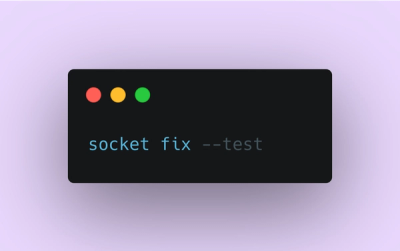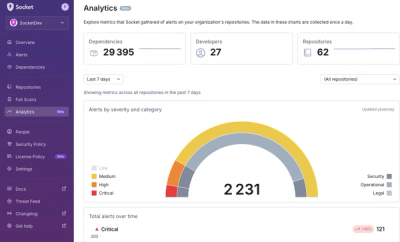
Product
Introducing Socket Fix for Safe, Automated Dependency Upgrades
Automatically fix and test dependency updates with socket fix—a new CLI tool that turns CVE alerts into safe, automated upgrades.
@mapbox/graph-normalizer
Advanced tools
Takes nodes and ways and turn them into a normalized graph of intersections and ways.
graph-normalizer is a JavaScript module that performs operations on an array of GeoJSON LineStrings representing OpenStreetMap ways. The operations performed cover a standard set of graph normalization techniques such as merging edges between intersections and splitting edges that cross over intersections. Ids assigned to ways in the normalized graph are deterministic and reproducible.
npm install @mapbox/graph-normlizer
npm test
npm run bench
var normalizer = require('@mapbox/graph-normalizer');
var ways = require('./ways.json');
var splitWays = normalizer.splitWays(ways);
var mergedWays = normalizer.mergeWays(ways);
console.log(JSON.stringify(ways));
Any ways that traverse an intersection are split in two. !<i> is appended to the way id where i is the index of the split way in the original geometry. Note that !0 is appended to the way id if there is no split.
Ways that share a node which is not an intersection (only 2 way owners) are merged together. The resulting id is <wayOne>,<wayTwo>.
refs array signifying node Ids of the coordinates that make up the way used for topology constructionid property representing the OpenStreetMap id of the wayhighway property representing the OpenStreetMap highway tag of the wayoneway property representing the OpenStreetMap oneway tag of the way
oneway property must be normalized to 0, 1, or -10 signifies a bidirectional way1 signifies a oneway way traveling in coordinate order-1 signifies a oneway way traveling in reverse coordinate order (this will be normalized to forward order 1)yes, or nohighway, oneway, bridge, tunnel and junction tags are conserved from the original graph by default.highway, bridge, tunnel and junction tags can be merged using optional arguments. When merging different tags:
highway tag is set as unclassifiedtunnel tag is set to yes i.e. we keep the info that there is a tunnel in the merged waybridge tag is set to yes i.e. we keep the info that there is a bridge in the merged wayjunction tag is set we keep the info about the junction in the merged wayFAQs
Takes nodes and ways and turn them into a normalized graph of intersections and ways.
We found that @mapbox/graph-normalizer demonstrated a not healthy version release cadence and project activity because the last version was released a year ago. It has 14 open source maintainers collaborating on the project.
Did you know?

Socket for GitHub automatically highlights issues in each pull request and monitors the health of all your open source dependencies. Discover the contents of your packages and block harmful activity before you install or update your dependencies.

Product
Automatically fix and test dependency updates with socket fix—a new CLI tool that turns CVE alerts into safe, automated upgrades.

Security News
CISA denies CVE funding issues amid backlash over a new CVE foundation formed by board members, raising concerns about transparency and program governance.

Product
We’re excited to announce a powerful new capability in Socket: historical data and enhanced analytics.